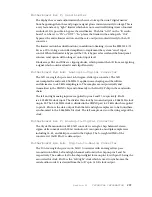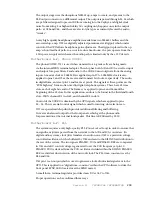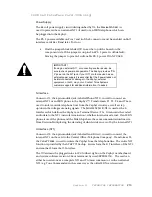
Section 11 TECHNICAL INFORMATION
215
Mitel chip. If the INFO 0 signal
is
present at the chip, possibilities include cold solder
joints, shorted diodes (D2, D3, D4, D5), or a broken wire inside transformer T1.
The Mitel chip uses crystal Y1 for internal timing. A 4 MHz signal should be present on
pins 7 and 8 of U2. If this signal is not present, replace Y1.
The other half of the S/T Interface is the NT1 chip (AT&T T7256). The S/T Bus signals
from the Mitel chip pass through T4 and T5 to the 4 wire connection on the AT&T chip.
Pins 23 and 24 (TNR and TPR) make up the NT1 transmit pair, and pins 26 and 27 (RNR
and RPR) are the receiver. INFO 0 should appear at the receive pins with no cables
attached.
The diode bridge networks are used for input protection, and the resistors R20, R21,
R22, R23, R24, R25, R26 and R27 are used for signal conditioning on the analog S/T
signals.
U-Interface Detail
The U- Interface is a 2- wire (ring and tip - to be consistent with analog terminology)
signaling protocol proscribed by the ISDN standards. The U is the last interface that a
subscriber must deal with between the terminal equipment (Zephyr, telephone, etc.)
and the central office. An NT1 is used to change from the 2- wire standard to the 4- wire
S/T Bus that all terminal equipment uses. The new ISDN card provides the NT1 internal
to the Zephyr, allowing the user to plug the 2- wire U- Interface directly into the Zephyr.
The entire U- Interface (and NT1) portion of the card is maintained by the AT&T 7256
chip (U4).
The U- Interface wires come into the card on pins 3 and 4 of the 6 pin modular jack (J2)
labeled Line/Direct. D17 (a Teccor
®
Sidactor
TM
) is used for input overvoltage protection
(i.e. lightning, etc.). T3, a Valor PT4084, isolates the line from the circuitry, and provides
some signal conditioning. C18 and C19 are filter caps to remove high frequency noise
from the analog signals. Pins 31 and 36 (HN and HP) are the inputs for the U- Interface,
and pins 32 and 35 are the transmitter outputs. The receiver and transmitter share the
same copper pair for signaling.
The AT&T chip runs off the 15.36 MHz crystal, Y2. This oscillator signal must
be present for the onboard logic and PLL to function. The chip will lock to the network
clock rate for signal synchronization.
U7 (LH1465AB) is used to extract certain “maintenance” pulse from the ISDN bitstream.
The pulses are transmitted to the AT&T chip through the opto- isolator, U6 (6N139).
The NT1 chip will use these maintenance pulse in communication with the central
office during execution of special functions (e.g. loopback).
Indicators and Information:
There are two indicators of the status of the ISDN connection: the front panel,
and the rear panel LED. The LED will blink at different rates to indicate status of the
NT1 and its connection to the central office. If the NT1 is completely dead or otherwise
inactive the LED will remain in the OFF state. If the AT&T chip is alive, it will try to
activate a connection with the central office. This is indicated by a rapidly blinking LED
(about 5 Hz). If the U- Interface cable is properly attached and the NT1 chip can contact
Summary of Contents for Zephyr
Page 13: ...Table of Contents 13 SECTION 1 QUICK RESULTS ...
Page 26: ...Section 2 INTRODUCTION 26 This page intentially left blank ...
Page 27: ...Section 2 INTRODUCTION 27 SECTION 2 INTRODUCTION ...
Page 38: ...Section 2 INTRODUCTION 38 This page intentionally left blank ...
Page 39: ...39 SECTION 3 ZEPHYR AT A GLANCE ...
Page 52: ...Section 4 INSTALLATION BASIC OPERATION 52 This page intentionally left blank ...
Page 53: ...Section 4 INSTALLATION BASIC OP 53 SECTION 4 INSTALLATION BASIC OPERATION ...
Page 84: ...Section 4 INSTALLATION BASIC OPERATION 84 ...
Page 85: ...Section 5 ISDN 85 SECTION 5 ISDN ...
Page 105: ...Section 6 NON ISDN NETWORKS 105 SECTION 7 AUDIO CODING ...
Page 118: ...Section 7 AUDIO CODING PRINCIPLES 118 This page intentionally left blank ...
Page 119: ...Section 8 DETAILED MENU REFERENCE 119 SECTION 8 DETAILED MENU REFERENCE ...
Page 157: ...Section 9 REMOTE CONTROL 157 SECTION 9 REMOTE CONTROL ...
Page 176: ...Section 9 REMOTE CONTROL 176 This page intentionally left blank ...
Page 177: ...Section 10 ADVANCED PROBLEM SOLVING 177 SECTION 10 ADVANCED PROBLEM SOLVING ...
Page 196: ...Section 10 ADVANCED PROBLEM SOLVING 196 This page intentionally left blank ...
Page 197: ...Section 11 TECHNICAL INFORMATION 197 SECTION 11 DETAILED TECHNICAL INFORMATION ...
Page 219: ...Section 12 SCHEMATICS 219 SECTION 12 SCHEMATICS ...
Page 221: ...Section 13 MANUFACTURER S DATA SHEETS 221 SECTION 13 MANUFACTURER S DATA SHEETS ...
Page 223: ...Section 14 SPECIFICATIONS WARRANTY 223 SECTION 14 SPECIFICATIONS AND WARRANTY ...
Page 228: ...228 This page intentionally left blank ...
Page 229: ...Section 15 APPENDICES 229 SECTION 15 APPENDICES ...






























